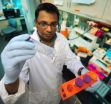Hope for patients with HIV-associated cognitive impairment
Researchers discover compounds in green tea and chocolate may help reduce neurological complications linked to HIV
2012-08-14
(Press-News.org) Current drug therapy for patients with HIV is unable to control the complete replication of the virus in the brain. The drugs therefore do not have any effect against the complications associated with neurocognitive impairment in patients with HIV. New research by Joseph Steiner and colleagues from Johns Hopkins University has discovered that a group of plant polyphenols known as catechins, which naturally occur in green tea and the seed of the cacao tree, may help in the prevention of these neurological complications. Their work is published online in Springer's Journal of NeuroVirology.
Previous research has established the critical role of a protein called brain-derived neurotrophic factor (BDNF) in supporting the survival and growth of neurons in the brain. This protein is active in areas of the brain vital to learning, memory and higher thinking. Patients with HIV have been found to have lower levels of BDNF in their brains than healthy individuals suggesting that this could be directly responsible for the cognitive impairment suffered.
In their research, Steiner and colleagues analysed the effects of 2000 compounds, containing both natural substances and FDA-approved drugs, on brain cells in the laboratory. They identified a series of compounds which had the potential to help protect neurons in the brain. Nine of these were related to epicatechin, which is found in cocoa and green tea leaves. Further screening and comparison with resveratrol, the antioxidant found in red wine, specifically identified epicatechin and epigallocatechin gallate (EGCG) as being the most effective at helping protect neurons by inducing production of BDNF.
Although the antioxidant activities of epicatechin and EGCG are well documented, the discovery that they could be responsible for inducing production of BDNF is an exciting advancement in this area. The fact that these compounds readily cross the blood-brain barrier further increases their therapeutic potential, as this is often a major stumbling block in the development of therapies directed at the brain. This provides hope for patients with HIV as there is currently no neuroprotective therapy available for patients with HIV-associated cognitive impairment.
The authors conclude: "Due to its simpler structure and more efficient blood-brain barrier penetration properties, epicatechin might be the best therapeutic candidate for neurodegenerative diseases. These include HIV-associated cognitive disorders where oxidative stress is an important pathophysiological mechanism." Further research in patients with HIV is required to elucidate just how effective these naturally occurring compounds could be.
INFORMATION:
Reference
Nath S, Bachani M, Harshavardhana D, Steiner JP (2012). Catechins protect neurons against mitochondrial toxins and HIV proteins via activation of the BDNF pathway. Journal of NeuroVirology. DOI 10.1007/s13365-012-0122-1
The full-text article is available to journalists on request.
END
ELSE PRESS RELEASES FROM THIS DATE:
2012-08-14
Researchers in Leuven (VIB/KU Leuven) have confirmed their hypothesis that normalizing blood vessels by blocking oxygen sensor PHD2 would make chemotherapy more effective. They also demonstrated for the first time that this strategy would reduce the harmful side effects of chemotherapy on healthy organs.
Limited success of chemotherapy
The effectiveness of chemotherapy is first and foremost limited by the difficulties of delivering the anticancer drugs to the actual tumor. Tumors are characterized by abnormally shaped blood vessels – they are irregular in shape, have ...
2012-08-14
TEMPE, Ariz. – Earthquakes are among the most destructive and common of geologic phenomena. Several million earthquakes are estimated to occur worldwide each year (the vast majority are too small to feel, but their motions can be measured by arrays of seismometers). Historically, most of Arizona has experienced low levels of recorded seismicity, with infrequent moderate and large earthquakes in the state. Comprehensive analyses of seismicity within Arizona have not been previously possible due to a lack of seismic stations in most regions, contributing to the perception ...
2012-08-14
Experts agree that, more than ever before, modern wars will be fought in the cyber zone, targeting an enemy's communications technology to cause untold damage. Now a Tel Aviv University researcher is suggesting that the same tactics should be employed in the battle against one of the body's deadliest enemies — cancer.
In an article published in Trends in Microbiology, Prof. Eshel Ben-Jacob of TAU's School of Physics and Astronomy and Prof. Herbert Levine of Rice University, long-time bacteria researchers, and Prof. Donald Coffey of Johns Hopkins University, a renowned ...
2012-08-14
AUGUSTA, Ga. – Connecting the dots between two molecules whose levels are decreased in depression and increased by current antidepressants could yield new therapies, researchers say.
Serotonin is a neurotransmitter that enables brain cells to communicate and brain-derived neurotropic factor, or BDNF, is a brain-nourishing molecule that also aids connectivity. Popular antidepressants such as Prozac, developed to increase levels of serotonin, have recently been found to also increase BDNF levels, said Dr. Anilkumar Pillai, neuroscientist at the Medical College of Georgia ...
2012-08-14
New Rochelle, NY, August 14, 2012—Community pharmacies with specially trained staff to provide HIV services can help HIV-infected individuals be more compliant with their essential antiviral drug regimens and hence improve patient outcomes. Users of HIV-specialized Walgreen pharmacies across the U.S. had significantly greater adherence to and persistence with their therapeutic drug regimens according to a study published in AIDS Patient Care and STDs, a peer-reviewed journal from Mary Ann Liebert, Inc., publishers. The article is available free on the AIDS Patient Care ...
2012-08-14
UPTON, NY - Scientists taking advantage of the versatility and new capabilities of the Relativistic Heavy Ion Collider (RHIC), an atom smasher at the U.S. Department of Energy's Brookhaven National Laboratory, have observed first glimpses of a possible boundary separating ordinary nuclear matter, composed of protons and neutrons, from the seething soup of their constituent quarks and gluons that permeated the early universe some 14 billion years ago. Though RHIC physicists have been creating and studying this primordial quark-gluon plasma (QGP) for some time, the latest ...
2012-08-14
EAST LANSING, Mich. — Soil microbes are impulsive. So much so that they help plants face the challenges of a rapidly changing climate.
Jen Lau and Jay Lennon, Michigan State University biologists studied how plants and microbes work together to help plants survive the effects of global changes, such as increased atmospheric CO2 concentrations, warmer temperatures and altered precipitation patterns. The results, appearing in the current issue of the Proceedings of the National Academy of Sciences, showed that microbes in the ground not only interact with plants, but they ...
2012-08-14
Researchers at Virginia Commonwealth University Massey Cancer Center are reporting promising results from laboratory and animal experiments involving a new combination therapy for multiple myeloma, the second most common form of blood cancer.
The study published online in the journal Cancer Research details a dramatic increase in multiple myeloma cell death caused by a combination of the drugs obatoclax and flavopiridol. The researchers, led by Steven Grant, M.D., Shirley Carter Olsson and Sture Gordon Olsson Chair in Oncology Research, associate director for translational ...
2012-08-14
CAMBRIDGE, Mass. -- Tissue implants made of cells grown on a sponge-like scaffold have been shown in clinical trials to help heal arteries scarred by atherosclerosis and other vascular diseases. However, it has been unclear why some implants work better than others.
MIT researchers led by Elazer Edelman, the Thomas D. and Virginia W. Cabot Professor of Health Sciences and Technology, have now shown that implanted cells' therapeutic properties depend on their shape, which is determined by the type of scaffold on which they are grown. The work could allow scientists to ...
2012-08-14
WASHINGTON, Aug. 14, 2012-- To warn of chemical attacks and help save lives, it's vital to quickly determine if even trace levels of potentially deadly chemicals—such as the nerve gas sarin and other odorless, colorless agents—are present. U.S. Army researchers have developed a new chemical sensor that can simultaneously identify a potentially limitless numbers of agents, in real time. A paper describing the system has been published today in the Optical Society's (OSA) journal, Optics Letters.
The new system is based on a phenomenon known as the photoacoustic effect, ...
LAST 30 PRESS RELEASES:
[Press-News.org] Hope for patients with HIV-associated cognitive impairment
Researchers discover compounds in green tea and chocolate may help reduce neurological complications linked to HIV




